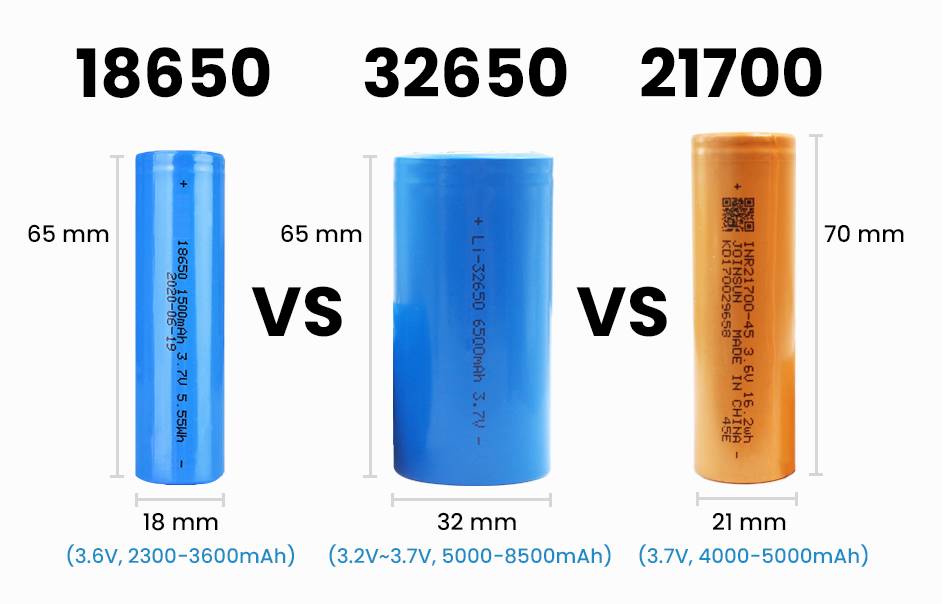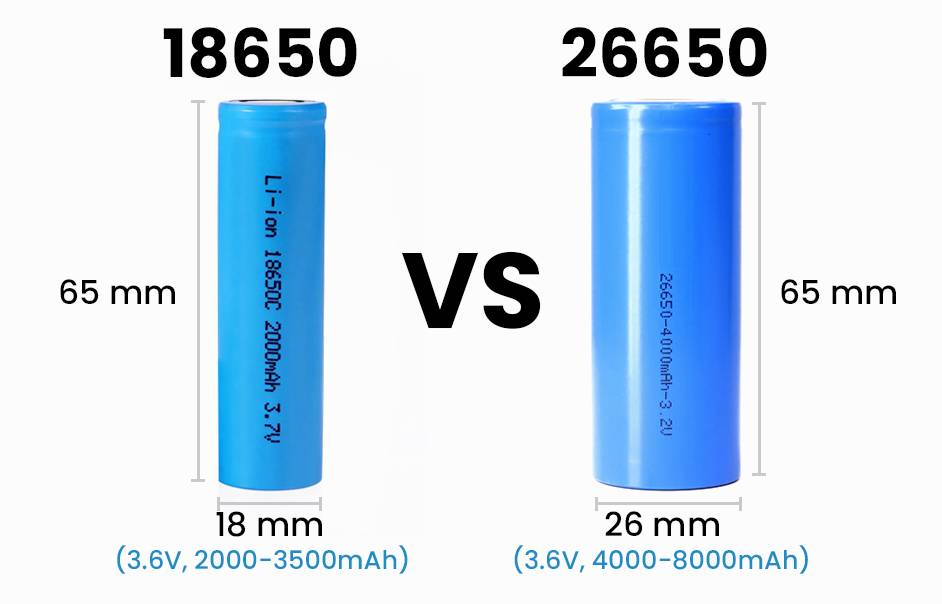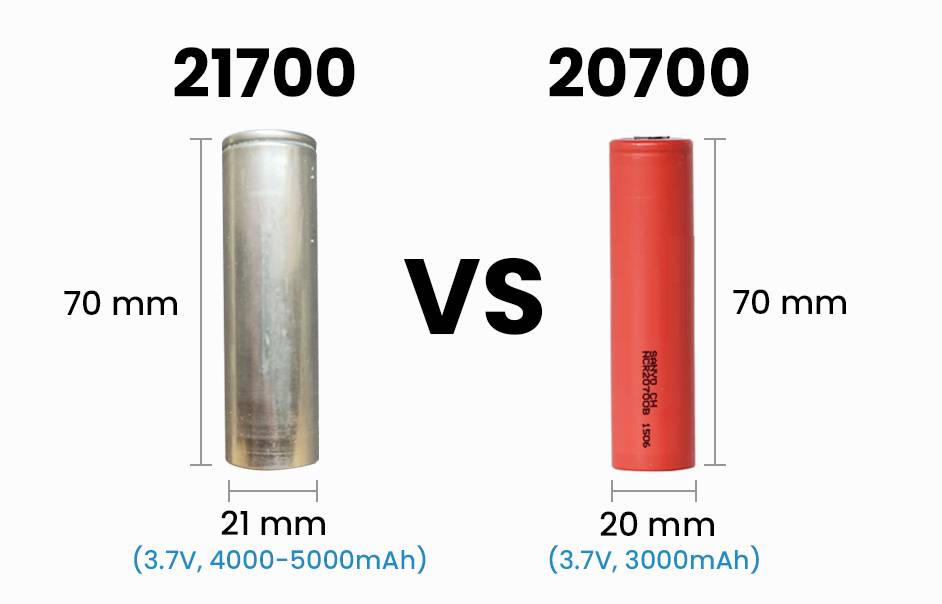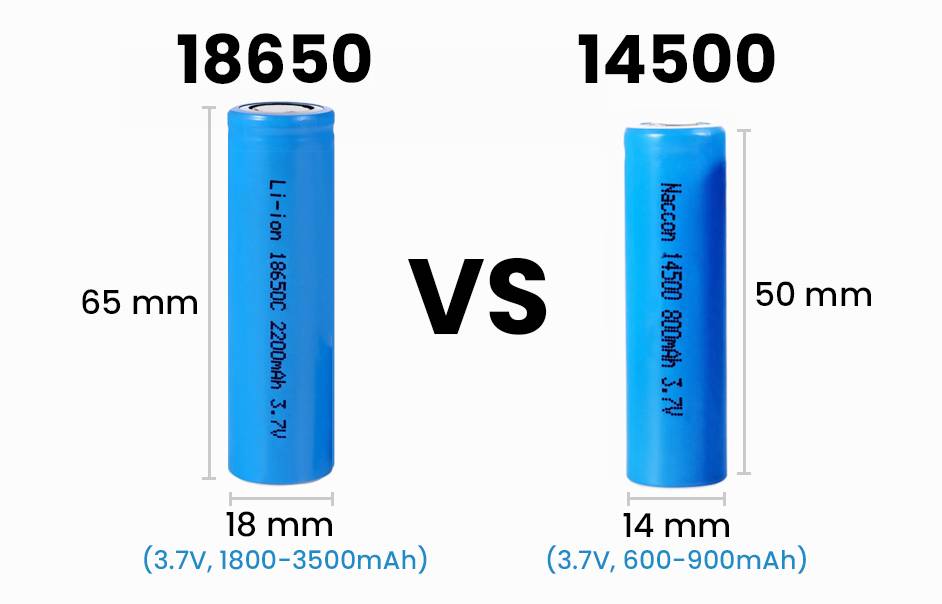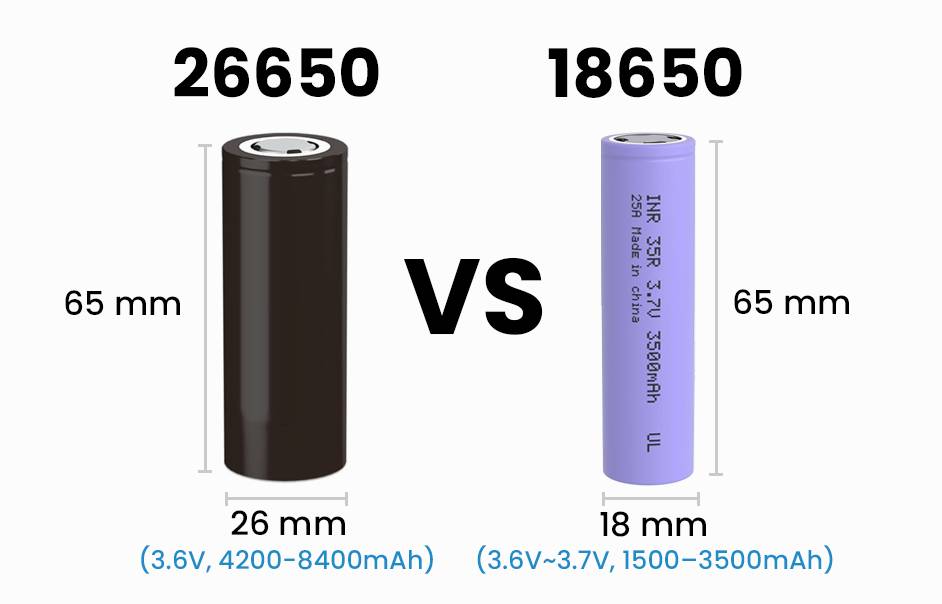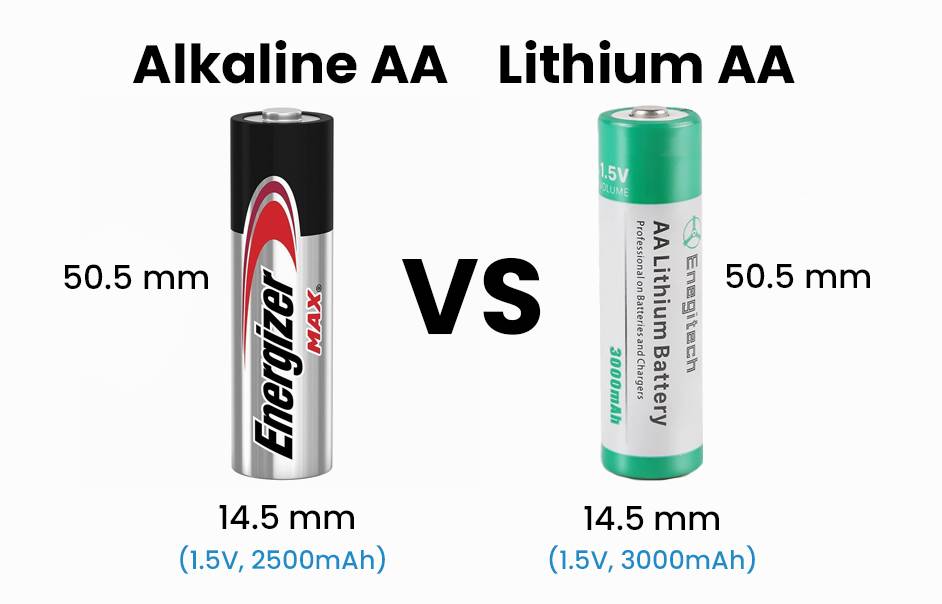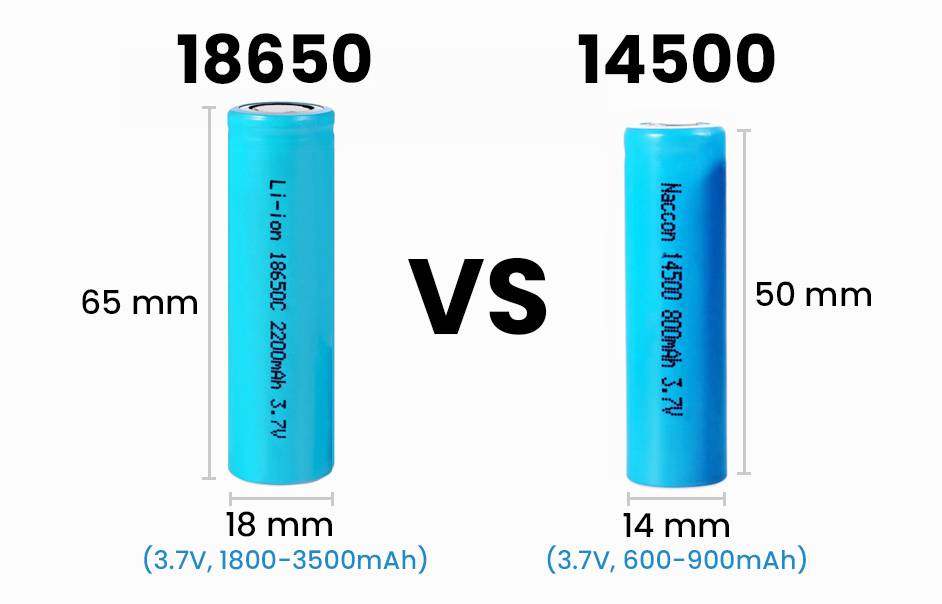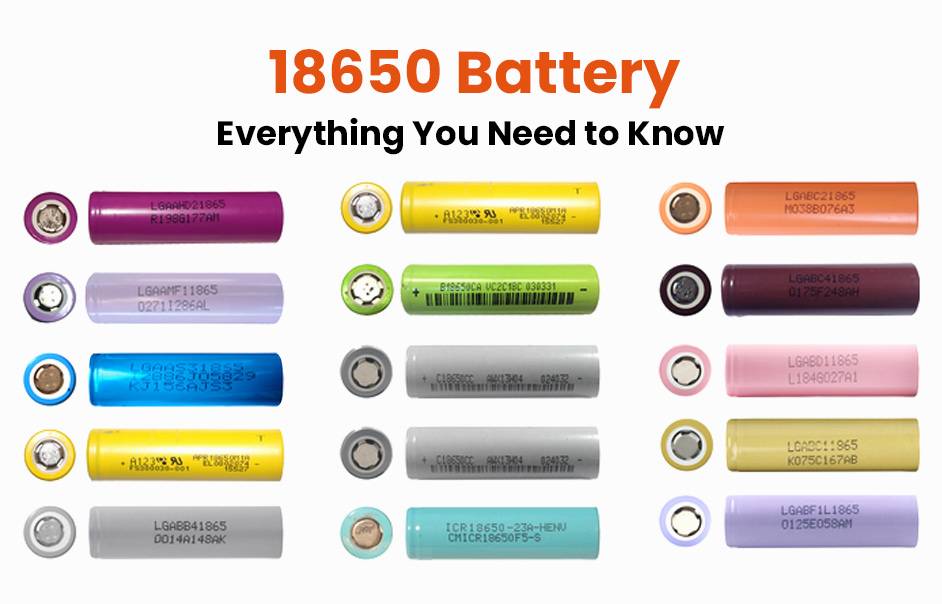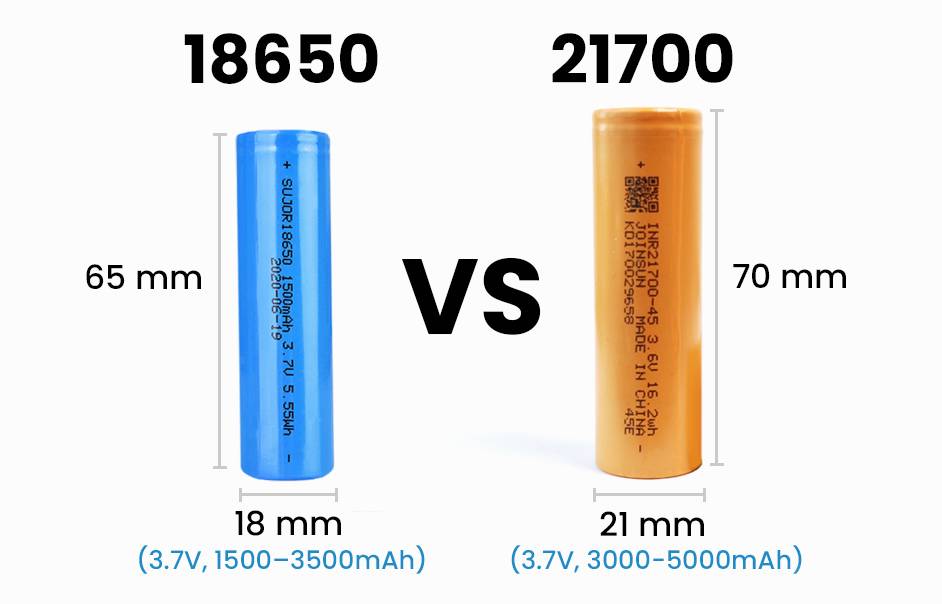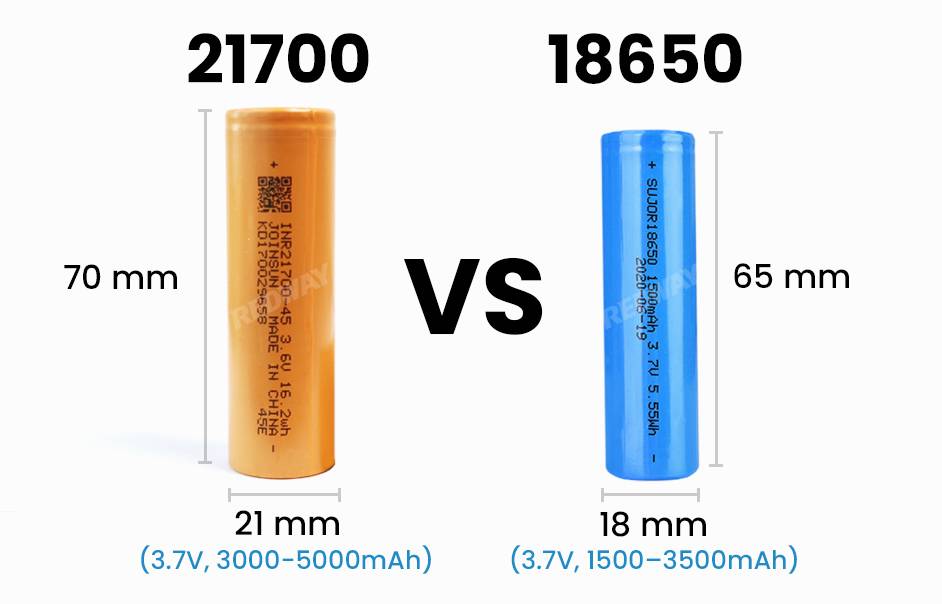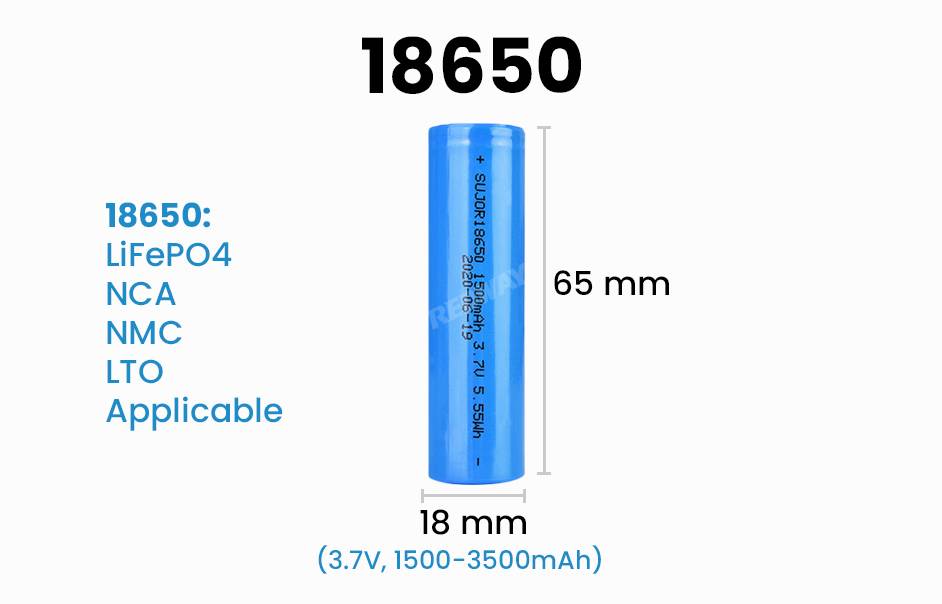Explore the world of lithium batteries in our comprehensive guide, comparing three popular types: 18650, 21700, and 32650. Dive into the world of 18650, 21700, and 32650 batteries to discover which one packs a punch when it comes to energy density and performance. Whether you’re a tech enthusiast, electric vehicle driver, or DIY aficionado, understanding the differences between these lithium powerhouses can help you make an informed choice for all your battery-powered needs. Let’s explore the ins and outs of these high-energy cells!
Comparison of 18650, 21700, and 32650 Batteries
Discover the world of lithium batteries with three popular options: 18650, 21700, and 32650.
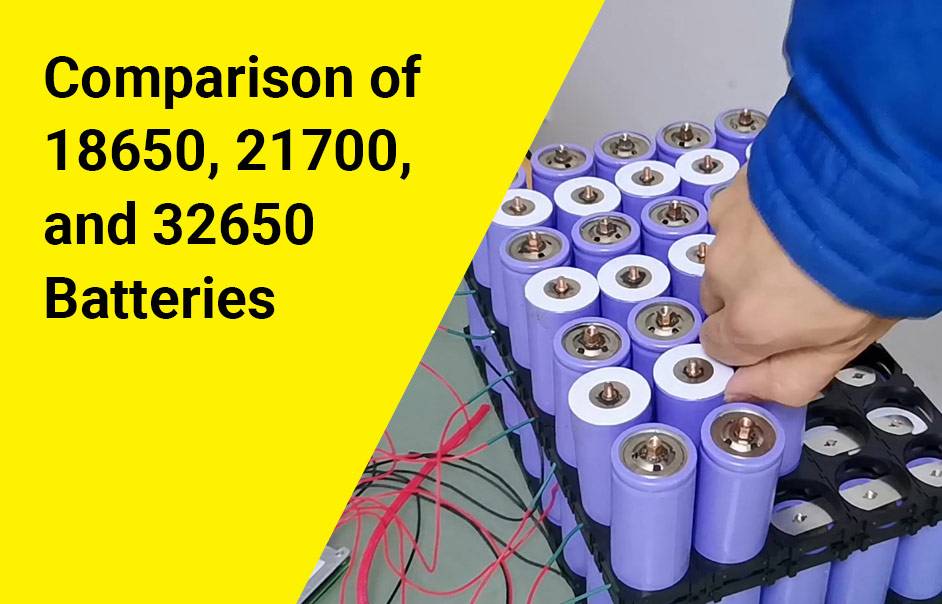
- 18650 Battery:
- Compact and versatile, ideal for laptops, flashlights, and power tools.
- Offers a capacity range of 1800mAh to 3500mAh, perfect for extended use.
- 21700 Battery:
- Larger and more powerful, suitable for applications requiring higher capacity.
- Capacities range from 3000mAh to over 5000mAh, providing extended power without frequent recharging.
- 32650 Battery:
- Hefty and powerful, designed for high-drain devices like electric vehicles.
- Boasts a substantial capacity of up to 6000mAh or more, ideal for large-scale energy storage.
Additional Considerations:
- All three batteries exhibit excellent voltage output and discharge rate capabilities.
- Size and weight decrease with the increasing number in the battery name (e.g., “18650” is smaller than “21700”).
- Cost analysis, including initial purchase price and overall lifespan, aids in determining cost-effectiveness.
Choosing the right lithium battery depends on both specifications and the specific needs of your application.
Select wisely to ensure optimal performance for your devices.
Key Differences Between 18650, 21700, and 32650 Batteries
When it comes to lithium batteries, size matters. The 18650 battery is the smallest of the three options, with a diameter of just 18mm. In contrast, the 21700 and 32650 batteries are larger in size. This difference in dimensions directly impacts their energy storage capacity.
In terms of energy density, the 21700 battery offers higher capacities compared to both the 18650 and 32650 variants. This makes it ideal for applications requiring high energy output like electric vehicles and power tools. On the other hand, while the 18650 cell may have lower capacities, its compact size makes it popular for use in electronic equipment that demand smaller form factors.
Another key distinction lies in discharge rates – where higher discharge rates are achievable with the larger-sized batteries like the 21700 and especially the robust 32650 variant suited for high power applications needing strong current outputs.
Advantages and Disadvantages of Each Battery Type
When it comes to lithium batteries, each type has its own set of advantages and disadvantages. Let’s explore them below.
18650 batteries are popular for their compact size and high energy density. They are commonly used in portable electronic devices like laptops and flashlights. However, they may not offer the highest capacity compared to larger options.
21700 batteries, on the other hand, provide a balance between size and capacity. With a larger diameter of 21mm, these batteries can store more energy than 18650 cells. They are often used in electric vehicles and power tools for their higher capacities.
32650 batteries excel in high-power applications due to their larger size and ability to handle higher discharge rates. These batteries are commonly found in energy storage systems and electronic equipment that require a reliable power source.
Consider the specific requirements of your device when choosing between these battery types to ensure optimal performance.
Popular Uses for Each Battery Type
18650 batteries are commonly used in a variety of electronic devices such as laptops, flashlights, and power banks. Their compact size and high energy density make them ideal for portable gadgets that require reliable battery power.
On the other hand, 21700 batteries are becoming increasingly popular in applications like electric vehicles and high-power tools due to their larger capacity and higher discharge rates. The ability to provide sustained high power output makes them suitable for demanding tasks that require a robust energy source.
32650 batteries, with their even larger diameter of 32mm, are typically found in energy storage systems and electronic equipment where high capacity is essential. These batteries excel at providing long-lasting power for devices that need to operate continuously without frequent recharging.
Each battery type caters to specific needs based on its unique characteristics, making it crucial to choose the right one according to the requirements of your device or application.
Performance Differences: Capacity, Voltage, and Discharge Rate
When comparing lithium batteries, consider key performance factors: capacity, voltage, and discharge rate.
- Capacity:
- 18650: 2,000mAh to 3,500mAh.
- 21700 and 32650: Over 4,000mAh, reaching up to 5,000mAh.
- Larger capacities in bigger batteries mean longer runtimes.
- Voltage:
- All operate at around 3.7 volts when fully charged.
- 21700 and 32650 exhibit slightly higher voltages under load due to lower internal resistance.
- Discharge Rate:
- Larger cells (21700, 32650) have higher continuous discharge rates.
- Increased surface area and heat dissipation capabilities contribute to better performance.
Understanding these differences guides the selection of the right lithium battery for specific needs!
Size and Weight Comparison
Consider size and weight when choosing a lithium battery: 18650, 21700, and 32650.
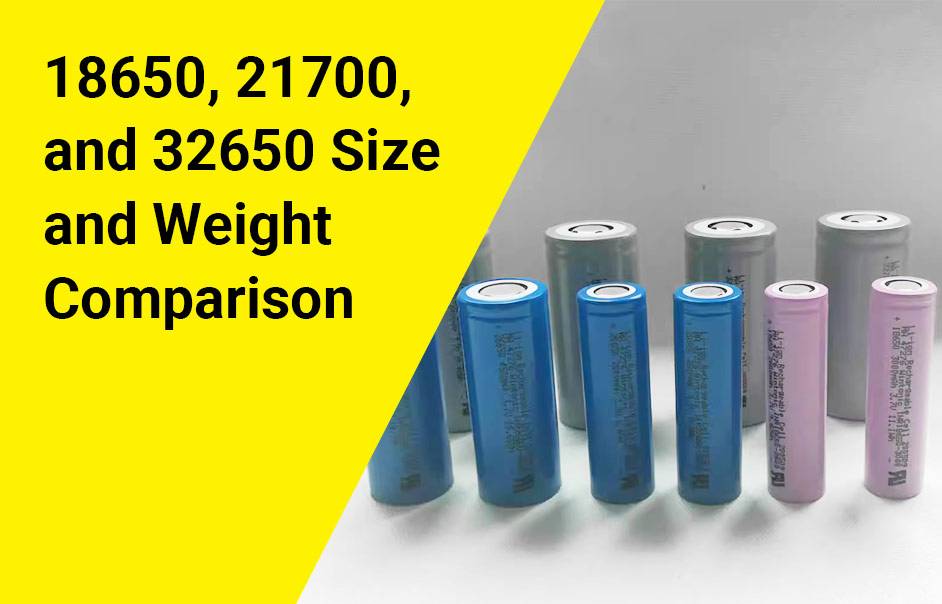
- 18650:
- Diameter: 18mm, Length: 65mm.
- Compact and lightweight, suitable for laptops and power tools.
- 21700:
- Diameter: 21mm, Length: 70mm.
- Slightly larger than 18650, balancing increased capacity with reasonable size.
- 32650:
- Diameter: 32mm, Length: 650mm.
- Hefty and powerful, ideal for electric vehicles and energy storage with less space constraints.
Consider your device’s requirements and limitations regarding space and weight. Smaller batteries offer portability, while larger ones provide higher capacities at the cost of increased weight. Align technical specifications with practical considerations for optimal battery selection.
Cost Comparison of the Three Battery Types
When it comes to comparing the cost of 18650, 21700, and 32650 lithium batteries, several factors come into play. The price of each battery type can vary based on the brand, quality, and capacity.
18650 batteries are commonly known for their affordability due to their widespread use in various electronic devices. However, with advancements in technology, the cost of 21700 and 32650 batteries has become more competitive.
The larger size of 21700 and 32650 batteries may result in a slightly higher upfront cost compared to the compact 18650 cells. Despite this difference, the higher energy density and capacity offered by these larger batteries can provide better value over time.
It’s essential to consider your specific power requirements when evaluating the cost-effectiveness of different battery types for your device or application. Conducting thorough research and comparing prices from reputable suppliers will help you make an informed decision that aligns with your budget without compromising performance.
Consider cost when choosing a lithium battery: 18650, 21700, and 32650.
- 18650:
- Most affordable due to widespread availability and established manufacturing.
- Common choice for budget-conscious consumers.
- 21700 and 32650:
- Larger size and higher capacities can lead to a higher price point.
- Advances in technology and increased demand may result in future cost reductions.
Factors affecting cost include brand, quality, and capacity. Online retailers may offer competitive prices. When analyzing cost, consider upfront expenses versus long-term benefits. While initial costs may be higher for some, superior performance can offset expenses over time, providing longer usage. Prioritize durability and lifespan in your purchasing decision.
Applications and Uses for Each Battery Type
Explore the applications of lithium batteries:

- 18650 Batteries:
- Compact and high energy density.
- Widely used in laptops, power banks, flashlights, and electric cigarettes.
- 21700 Batteries:
- Improved capacity for longer runtimes.
- Ideal for electric vehicles, drones, and cordless power tools.
- Used in renewable energy storage systems.
- 32650 Lithium Batteries:
- Excel in heavy-duty applications with high discharge rates.
- Power electric bikes or motorcycles requiring bursts of power during acceleration.
Versatility Beyond:
- Off-grid solar installations benefit from storing excess energy.
- Vital role in medical devices like pacemakers or defibrillators.
- Infiltrated the marine industry, providing reliable power for boats and yachts.
Overall, lithium batteries revolutionize industries with high energy density, prolonged lifespans, and fast charging capabilities.
Factors to Consider When Choosing the Right Battery
Considerations for Choosing the Right Lithium Battery:
- Capacity:
- Measured in mAh, higher capacity means longer runtime before recharge.
- Voltage:
- Match the battery voltage to the device’s requirement to avoid damage or malfunction.
- Discharge Rate:
- Choose a high discharge rate for power-hungry devices like flashlights or electric vehicles.
- Size and Weight:
- Balance portability and capacity; smaller batteries are more portable but have lower capacities.
- Cost:
- Consider affordability; 18650 is cost-effective, while newer models may offer better performance at a slightly higher cost.
Factors to Weigh:
- Smaller, lighter batteries for portability; larger, heavier ones for higher capacities.
- Consider specific applications; some batteries excel in electronics, others in high-drain tools or electric vehicles.
Conclusion: Choosing the right lithium battery involves balancing technical specifications with specific applications, considering capacity, voltage, discharge rate, size, weight, and budget constraints to meet individual needs.
Safety Concerns with Lithium Batteries
Prioritize safety when dealing with lithium batteries, considering potential risks and preventive measures.

- Thermal Runaway:
- Risk of overheating leading to fire or explosion.
- Mitigated by thermal protection circuits and flame-retardant materials.
- Short-Circuiting:
- Occurs if terminals contact metal objects or due to manufacturing defects.
- Handle batteries carefully to prevent rapid energy release.
- Overcharging:
- Charging beyond maximum voltage can lead to instability and failure.
- Ensure charging systems have safeguards like overcharge protection circuits.
- Proper Storage:
- Extreme temperatures or exposed environments can compromise battery integrity.
- Store in cool, dry places away from flammable materials.
Safety Tips:
- Use chargers designed for your battery type.
- Avoid mixing different types or brands.
- Don’t use damaged or swollen batteries.
- Never puncture or disassemble batteries.
- Dispose of old or damaged batteries properly according to local regulations.
Understanding safety concerns and taking precautions ensures the safe use of lithium batteries, allowing you to benefit from their high performance while minimizing associated risks.
Tips for Proper Care and Maintenance
Ensure optimal performance and longevity of lithium batteries with these care tips:
- Charge Correctly:
- Use recommended chargers for your specific battery type (18650, 21700, 32650).
- Avoid overcharging or undercharging to prevent overheating and reduce battery life.
- Avoid Extreme Temperatures:
- Keep batteries away from extreme hot or cold conditions.
- Avoid direct sunlight exposure and freezing conditions.
- Store Safely:
- Store batteries in a cool, dry place away from flammable materials.
- Consider using protective cases or holders designed for lithium batteries.
- Handle with Care:
- Exercise caution to prevent physical damage like dropping or crushing.
- Damaged batteries can be dangerous and should not be used.
- Regular Inspections:
- Periodically check for wear or damage such as bulging, leaks, or corrosion.
- Replace damaged batteries immediately.
- Don’t Mix Batteries:
- Avoid mixing different types during charging or device use to prevent imbalances.
- Proper Disposal:
- Follow local regulations for responsible disposal at recycling centers.
Following these tips ensures safe usage and maximizes the lifespan of lithium batteries.
How to Choose the Right Battery for Your Device
When it comes to choosing the right battery for your device, there are a few key factors to consider. Think about the power requirements of your device – does it need high energy density or high capacity? This will help determine which battery type is most suitable.
Consider the size limitations of your device as well. If you have a smaller electronic gadget, an 18650 cell might be more appropriate due to its diameter of 18mm. On the other hand, if space is not an issue and you need higher capacities, a 21700 or 32650 battery could be ideal.
Additionally, take into account the discharge rates needed for your device. Some applications like electric vehicles require high power output while others like power tools may prioritize longer run times. Understanding these requirements will guide you towards selecting the best lithium battery for optimal performance in your electronic equipment.
Conclusion
The 18650, 21700, and 32650 lithium batteries offer unique characteristics. The 18650 excels in versatility, balancing size and capacity for laptops and electric vehicles. The 21700 provides higher capacities, ideal for prolonged use in electric bicycles or power tools. The 32650 offers even greater capacities with enhanced safety features. Consider factors like capacity, voltage, discharge rates, and safety when choosing, ensuring alignment with specific application needs. Make an informed decision to meet your power requirements effectively.
FAQs
How Do 26650 & 21700 Batteries Compare?
Which is More Popular: 26650 or 21700?
Are 21700 & 26650 Batteries Interchangeable?
What Are the Pros and Cons of 21700 Batteries?
What Are the Pros and Cons of 26650 Batteries?
What’s the Difference Between 26650 and 21700 Batteries?
More FAQs
Which is better 32650 cell or 18650?
The suitability of a 32650 cell or an 18650 cell depends on the specific application and requirements. Generally, 32650 cells offer larger capacity and higher current handling capabilities compared to 18650 cells, making them suitable for high-power applications where energy density is less critical.
What is a 32650 battery used for?
32650 batteries are commonly used in applications that require high capacity and high current output, such as electric vehicles, energy storage systems, power tools, and solar energy storage.
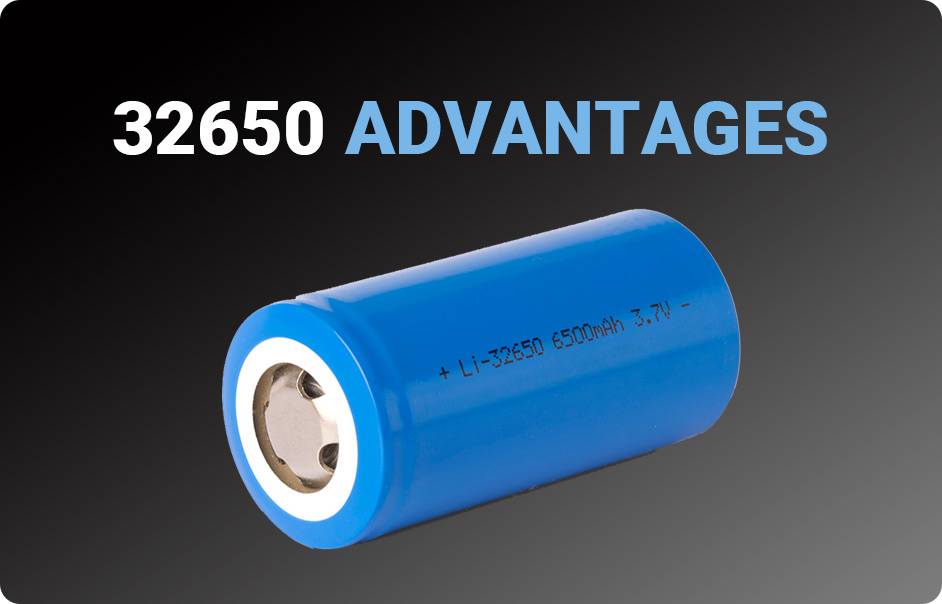
What is the difference between 18650 and 21700 lithium batteries?
The main difference between 18650 and 21700 lithium batteries is their size and capacity. 21700 batteries have a larger diameter and capacity compared to 18650 batteries, allowing for higher energy density and potentially better performance in certain applications.
What is the difference between 18650 and 21700 vs 46800?
The difference between 18650, 21700, and 46800 lithium batteries lies primarily in their size, capacity, and performance characteristics. 18650 batteries are smaller and have lower capacity compared to 21700 and 46800 batteries. 21700 batteries have a larger diameter and capacity than 18650 batteries, while 46800 batteries are even larger and typically offer higher capacity and power output.
What are the disadvantages of 18650 batteries?
Some disadvantages of 18650 batteries include lower capacity and energy density compared to larger battery formats like 21700 or 46800, as well as limitations in current handling capabilities for high-power applications.
Is 21700 better than 18650?
In many cases, 21700 batteries offer advantages over 18650 batteries, including higher capacity, higher current handling capabilities, and potentially better energy density. However, the suitability of each battery type depends on the specific requirements of the application.
Why are 21700 cheaper than 18650?
The relative pricing of 21700 and 18650 batteries can vary depending on factors such as manufacturing volumes, production efficiencies, and market demand. In some cases, higher demand or economies of scale for 21700 batteries may lead to lower production costs and subsequently lower prices compared to 18650 batteries.
Can I replace 18650 with 21700?
In many cases, it’s possible to replace 18650 batteries with 21700 batteries, especially if the device or application can accommodate the larger size of 21700 cells. However, it’s essential to consider factors such as voltage, capacity, and compatibility with charging and protection circuits when making the switch.
What are the advantages of 21700 battery?
Some advantages of 21700 batteries include higher capacity, higher current handling capabilities, potentially better energy density, and improved performance compared to smaller battery formats like 18650.
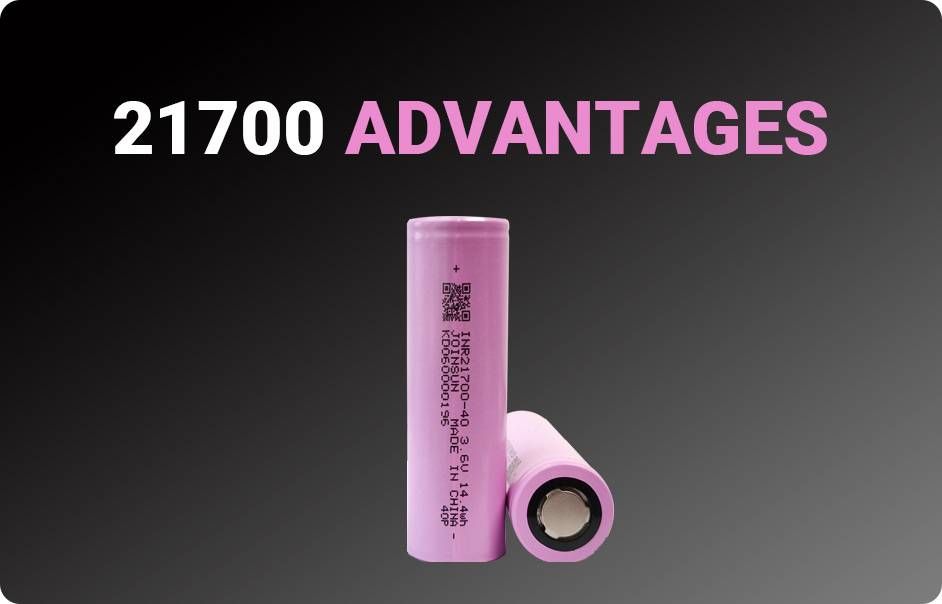
Does Tesla use 21700 batteries?
Yes, Tesla uses 21700 lithium-ion batteries in some of its vehicles, including the Model 3 and Model Y. These batteries, produced in collaboration with Panasonic at Tesla’s Gigafactory, offer higher energy density and improved performance compared to previous battery formats.
Which is better 21700 or 4680 battery?
The choice between 21700 and 46800 batteries depends on factors such as specific energy and power requirements, compatibility with existing systems, and manufacturing considerations. 46800 batteries offer larger size and potentially higher capacity and power output compared to 21700 batteries, but they may not be suitable for all applications due to size constraints.
What is the most powerful 21700 battery?
The most powerful 21700 batteries are those that offer the highest capacity and power output while maintaining safety and reliability. Specific models and brands may vary, but some notable high-performance 21700 batteries include those produced by companies like Samsung, LG Chem, and Panasonic.

